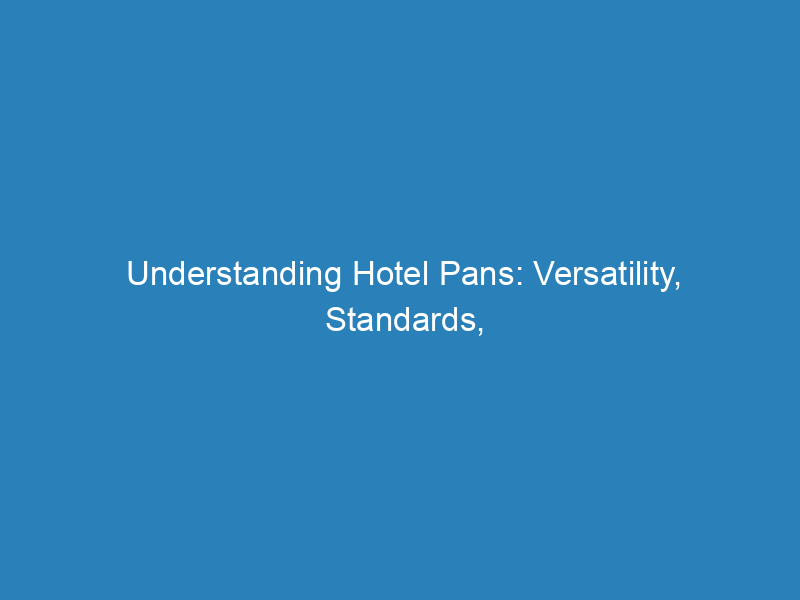
Understanding Hotel Pans: Versatility, Standards, and Uses in Food Service
When it comes to the culinary world, hotel pans play a pivotal role in food storage, holding, and serving across various dining settings. Often referred to as “steam table pans,” “service pans,” or “counter pans,” these versatile tools are essential in many restaurants and catering operations. With their robust design, hotel pans are primarily utilized in steam tables, allowing for efficient food service during busy meal periods.
The Origins of the Hotel Pan
The term “hotel pan” has an intriguing history that traces back to European practices, likely originating in France. In the past, hotels would schedule specific meal times for guests, a tradition still observed in cruise dining. To accommodate large groups, hotel operators required durable pans that could hold and serve substantial quantities of food efficiently. Thus, the hotel pan was created, and its name has persisted even as its use expanded beyond the hospitality sector to include various food service environments.
Understanding Hotel Pan Specifications
Hotel pans adhere to standardized dimensions and depths, which is crucial for compatibility with food service equipment. The full-size hotel pan measures 12 inches by 20 inches, a size that fits perfectly in steam tables designed with a grid to hold multiple pans. This allows for creative configurations, enabling restaurants and caterers to separate different dishes while maximizing space.
Depth and Gauge Standards
Hotel pans come in various depths, denoted by numbers such as “100,” “200,” and so forth, indicating the pan’s depth in inches. For example, a “100 pan” is about 1 inch deep, while a “200 pan” is approximately 2.5 inches deep. Understanding both the dimensions and depths of these pans is essential for planning your food service setup.
Additionally, the gauge of the stainless steel used in the construction of hotel pans is an important factor. A lower gauge number signifies higher-quality steel, with 22 gauge being the industry standard for most hotel pans. While there are lighter options available for less demanding tasks, investing in higher-quality pans can save money in the long run, as they tend to be more durable and energy-efficient.
Exploring Variations and Accessories
While hotel pans are typically rectangular, they come in various shapes and materials, including perforated designs for steaming or drainage. Materials can vary from stainless steel to polycarbonate plastic and melamine, with each type suited for different food temperatures and presentations. Some manufacturers even offer creatively shaped pans that can enhance the visual appeal of buffet displays.
Accessories play a crucial role in maximizing the functionality of hotel pans. Lids and covers, available in various materials and designs, help maintain food temperature and quality. Likewise, having a range of serving utensils—such as tongs, spatulas, and serving spoons—ensures that food can be served efficiently and hygienically.
A Timeless Tool in Food Service
Regardless of the setting—be it a bustling restaurant, an elaborate buffet, or a catering event—hotel pans remain an indispensable tool in the foodservice industry. With a variety of options available, including different sizes and materials, choosing the right hotel pan can elevate your food presentation and streamline your serving process.
Hotel Pan Sizing Overview
| Type | Size | Approx. Capacity (in qts by depth in inches) |
|---|---|---|
| Full Size Pan | 12″ x 20″ | 2 ½” – 5qt, 4″ – 8.13qt, 6″ – 21qt, 8″ – 29.75qt |
| Two-Thirds Pan | 12″ x 13 1⁄3″ | 2 ½” – 5.7qt, 4″ – 9.3qt, 6″ – 12.6qt, 8″ – 16.4qt |
| Half Pan | 12″ x 10″ | 2 ½” – 4.3qt, 4″ – 6.6qt, 6″ – 9.4qt, 8″ – 11qt |
| Third Pan | 12″ x 6 ⅔” | 2 ½” – 2.25qt, 4″ – 4.1qt, 6″ – 6.1qt, 8″ – 7.5qt |
| Quarter Pan | 6″ x 10″ | 2 ½” – 1.8qt, 4″ – 3qt, 6″ – 4.5qt, 8″ – 5.1qt |

